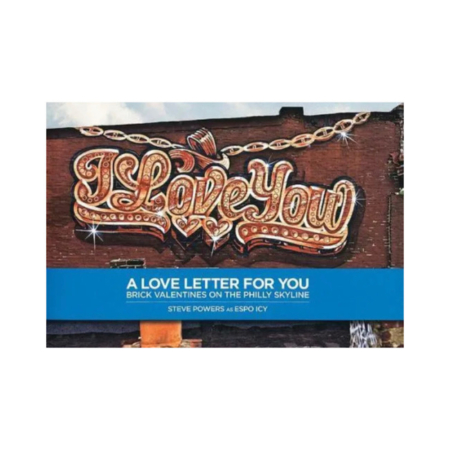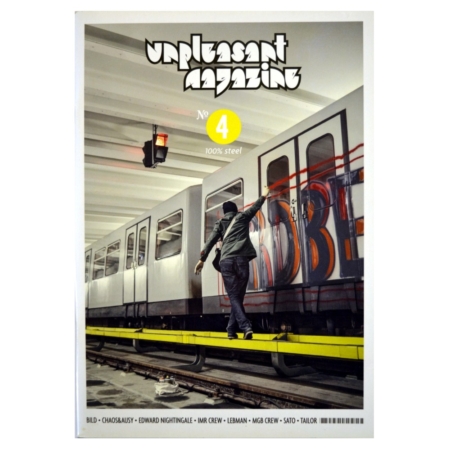Description
Title: The Art Of Getting Over
Subtitle: Graffiti At The Millennium
Author: Stephen Powers
Published: September 1999
Dimensions: 22,5 x 28 x 1,5 cm. / 8.9 x 11 x 0.6 inch.
Pages: 160
Hardcover
Language: English
Cover: 9.5/10 Inside: 10/10
Stephen “ESPO” Powers, an insider in the world of graffiti, examines its influence on today’s society, exploring the history of outdoor, uncensored art, interviewing early artists as well as current ones and providing readers with full-color illustrations of some important works.
What started as simple street movement, a way to assert individuality and pride, has blossomed into much more: Graffiti is everywhere. From Sprite commercials to The Source magazine to Soho art galleries, the elements and vernacular of the graffiti aesthetic are apparent in today’s society. This book examines graffiti’s influence from its earliest days to its undeniable ubiquity now. Written by an insider, it includes a general history, in-depth interviews with both the progenitors of the form and current artists, and full-color illustrations of the most important works over the last 30 years. Unlike other subcultures that have been corrupted by the media and the mainstream, graffiti has maintained its sense of the underground and its clandestine feel. The purity and integrity that have defined the graffiti writer’s mission have never faltered. The Art of Getting Over offers an unprecedented glimpse into this deeply affecting urban art form.
About the Author
The 5th youngest in a family of 6, Stephen Powers was born with a healthy appetite for attention. Acting up in class never quite satisfied, and learning to ride a unicycle was too hard, so he gorged himself on graffiti. Once filled, he attended the University of the Arts in Philadelphia, and began to push his work in the medium towards a continuous dialogue with the masses, first with painting, then publishing On the Go magazine. He lives and paints in New York City. This is his first book, although not the first time he’s been booked.
Reviews (found on the web) by unknown buyers:
Review 1
St. Martin’s Press delivers once again. With the same level of expertise afforded to punk and other marginal cultures, the publisher has set out to unleash an atomic bomb blast on the graffiti universe.
There has always been three planets which orbit the literary world of Modern Graffiti. In chronological order: The Faith of Graffiti, text by Norman Mailer; Getting Up by Craig Castleman; and Subway Art by Henry Chalfant and Martha Cooper. Add to this list Powers’ The Art of Getting Over.
Whereas other offerings have been outsiders looking in (and in most cases piss poor proceedings follow with the aforementioned exceptions), TAGO is as real as it gets. Give Powers’ credit for deleting the gratuitous ‘glossary’ which creeps its way in the amateur ranks and the insertion of style, both graphically and literary, which sets standards not soon to be superseded.
Review 2
Well first off, i thought this book was just another writers attempt to “get over” using the subculture from which he grew. After actually opening my eyes, and READING what was there, the book has a lot of info missed or glossed over by other notable publications, albeit a bit thin in total editorial content. Other books passed by the whole idea that elements of the subculture had evolved somewhere else, but mr. powers picks up the cut threads, noting specific writers (and events) in colorful detail. There is a nice mix of old school fliks, snapshots (which are perhaps even more interesting), and newer art. (i found the pics of old philidelphia handstyles -tags- probably the most interesting). Every aspect of the culture is found in this book, and not limited to one city or locale, which is (as far as i know)a first in the list “graffiti writer turns writer” publications. Some “kings” of the world may feel it is weak, or its another attempt at “getting over” using the rest of us, but, what are they doing? Is it a full description of the graffiit “world”? No. I am not sure that is entirely possible by one authors account. But it is a vital piece to a puzzle left by previous authors, and (in my opinion) the best book produced on the subject by a writer so far. So-drop your preconceptions, and READ IT. A solid publication. Get it. peace. HAZARD UGN, OHIO.
Review 3
Stephen Powers, aka ESPO, gives to the world of publishing, The Art of Getting Over. No, it is not a self-help book, but a journal documenting the escapades and works of Graf kings past and present. Bound in black ( thus resembling a graf head’s “peice book” ) it contains hundreds of full-colour and black white pictures, showing the different styles and forms of graffiti and the evolution thereof. Also, within the pages contains excerpts of the lives of the various artists, from the interesting ( The REVS ) to the near tragic ( GKAE from L.A. in particular ). Though at times one could get lost from the numerous crew & name dropping, it is noteworthy enough to warrant a place in Hip-Hop history. The highlight of this book is, of course, the amazing art displayed, featuring Mr. Powers’ impressions of the various faces of graf: wether it be block letters, wild styles, throw-ups, to the basic tag. It would have been of particular interest to have put in words the aesthetics of graf in greater detail by someone who is active in the art ( especially to the laymen ), but we only have tidbits here and there scattered through out that leaves the reader wanting some more. An excellent addition to any Hip-Hop library, it might just make a graf head out of you.
Review 4
This book is a piece of history. It is important. There are some nice anecdotes. There are also some great pictures, and that’s important because a lot of this art is temporary. Which is part of its beauty. So it is important that people know some history.
The history of graffiti is too vast to cover it all in such a short book, but the personal feel (and viewpoint) that Powers employs make this history come alive. The fact that New York City’s Mayor Rudy sent his graffiti task force into Mr. Powers’ residence to confiscate computer hard disks and other info related to this book because he didn’t like the activities of Mr. Powers is a further indication that it is important that this information be preserved. Acts of nonconformity often become co-opted and defused. Therefore it is essential that people remember the past so that it can’t be used against them and sold back to them in the form of a Sprite commercial or as a pair of Tommy Hilfiger jeans. Consumption isn’t rebellion. The act of purchasing this book isn’t rebellious. To “get over” on a society that wants to erase dissent, you need to read this book and preserve history in your memory so that it can’t be sold back to you in altered versions.
“The Art of Getting Over”: Read it. Learn it. Love it. Live it.









Reviews
There are no reviews yet.